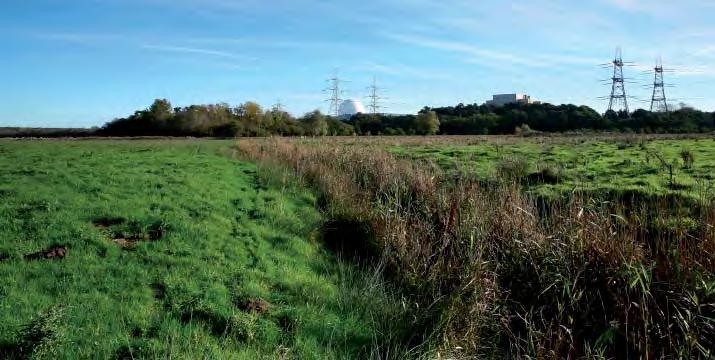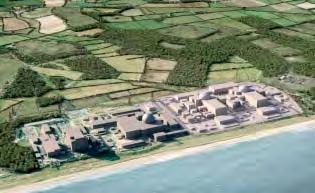
8 minute read
Sizewell ‘C’ - another blot on the landscape? ...........Phil Whittaker
Our Group’s Secretary expresses some concerns about the possibility of nuclear power generation being expanded in Suffolk.
Phil Whittaker Sizewell ‘B’, already a ‘blot’ on our landscape, might now be joined by ‘C’ - the ‘carbuncle’?
Suffolk’s biggest construction project Sizewell ‘C’ - another blot on our landscape?
It was pleasing to read in the local press recently that EDF Energy had won the Wildlife Trusts’ Biodiversity Benchmark for its efforts with Suffolk Wildlife Trust around the Sizewell ‘B’ site. Christine Blythe, EDF Energy’s biodiversity manager said; “We are making a positive contribution towards the conservation of biodiversity as we recognise how important it is to economic performance as well as our health and well being. The management of our site Sizewell ‘B’ contributes to the delivery of an integrated network of rich habitat along the Suffolk coast.” All ventures of this kind should of course be warmly applauded and recognised by anyone interested in conservation in Suffolk. However, those concerned about birds or wider conservation in Suffolk should be in no doubt about the impact, (if it is eventually given the green light) of the Sizewell ‘C’ twin reactor development project which is now in the early stages of the planning process. Suffolk Wildlife Trust and the RSPB, both with reserves immediately adjacent to the site, have expressed concern about the initial planning outlines submitted by EDF.

This is what ‘B’ plus ‘C’ will look like, excluding the extensive construction site access to the south and west
If this development takes place biodiversity loss with be significant and it is disquieting at the present time that the Stage 1 planning proposals offer little real detail about if, how, or where these losses will be offset by provision of a suitable package of reciprocal ecological benefit. Some of the concerns voiced by our local conservation organisations are: 1. Disturbance From noise and lighting during construction. This will be significant as it will be a prolonged nine-year project and potential disturbance may cover a 24-hour period. It is worth noting that many recently completed nuclear power plant projects have exceeded their initial time lines by many years. Disturbance will of course impact mostly upon Sizewell Belts SWT Reserve the closest next-door neighbour. Constructor sites will have to be established for the duration of the project, in the immediate area to house up to 5000+ workers and the location of these and the consequent population change and increased recreational pressure on such a small area is bound to have a major impact on sensitive wildlife sites nearby. 2. Loss of and fragmentation of SSSI habitat within the footprint of the construction site Birds, Barbastelle bats, Adder, newts, Natterjack Toads all use the proposed site. The scale of the footprint of the twin reactor site will mean a loss of a significant range of key species. Ecological surveys have taken place, but these relate to an earlier and smaller proposal and do not adequately assess the impact of the present scale of the proposed twin reactor site which, according to EDF, will eventually cover 305 hectares, including some of the present SSSI habitat. This figure does not account however for new roads, light railways and helicopter pads. 3. Possible changes to the distribution of marine and bird life offshore with new outfalls and jetties to be constructed and staying in place in the long-term, or even permanently. Ecologists assessing the possible impact of these structures are studying the seas off Sizewell and reports will be written to assess the possible impact on marine and bird life using the area. Many seabirds benefit presently from the water outfalls from Sizewell as the water from the reactors is pumped out and stirs up sediments and marine life. The potential impact of any new structure and its construction is presently unknown. A beneficial impact could be the provision of Kittiwake breeding platforms on any new proposed structure. Many birds from the arctic regions spend the winter at sea off Sizewell. The North Sea is a large area, but the undisturbed proportion is getting smaller, look out to sea there and you will easily spot Greater Gabbard’s hundreds of huge turbines now stretching along the coast as far as the eye can see in both directions. The impact of any development on wintering and migrating seabirds has yet to be fully assessed. Construction materials may also be obtained by off-shore dredging and this should not be considered until a full ecological assessment has taken place. 4. Coastal Erosion There may also be an impact on coastal erosion as a result of building a jetty and further outfalls. Minsmere has been defended from the sea recently; the North Wall barrier has been raised to shield this part of the reserve from the incursion of the sea, it is presently unknown how, or where, the coast could be eroded by changing tidal flow and the possible effects on the natural protection afforded by sand deposits protecting this stretch of coast. Again full ecological assessment must be undertaken and resultant concerns addressed.
5. Impact on the hydrology of Minsmere and in particular Minsmere Levels. ‘Run off’ of rainwater presents significant risks of further flooding. ‘Run off’ is responsible for a great deal of flooding in the UK. Every driveway that is made of tarmac or garden that is concreted over in towns contributes to it, i.e. water running off and not going into the ground. This could happen on a very large scale and result in flooding the nearby Minsmere Levels. Think of the run-off from your garden path multiplied by the huge proposed footprint of Sizewell! Present drainage is provided by Minsmere sluice that is insufficient and needs improving, as it can’t cope with present floodwater. The impact of ‘borrow pits’ for construction materials may also adversely affect the hydrology of the area, including Minsmere Levels (see map).

Minsmere Levels (blue areas) is immediately adjacent to both ‘B’ and proposed ‘C’.
Map © Crown copyright. All right reserved. SWT licence 10016410
There are many other areas of concern, for instance the visual impact of such a structure and the effects upon wildlife tourism and the likely knock-on effect on the economy of this area of Suffolk. At the time of writing Andy Smith, cabinet minister for planning at Suffolk Coastal, has raised serious concerns about the future development, not least that “EDF wish to withdraw most of the funding for our Sizewell team, and to limit their involvement with the community over the coming year” and that the benefits to local communities may now be considerably reduced. A role for SOG?
The membership of SOG should support the concerns of county and national organisations, as the sheer scale of the Sizewell ‘C’ development will impinge significantly on an existing SSSI and impact considerably on what is perhaps one of the most significant parts of our coastline for resident birds and a nationally and internationally important migration flyway. As a conservation organisation we need to keep a weather-eye on the Sizewell ‘C’ developments and seek to ensure that, the development and future management of Sizewell ‘C’ continues to contribute, in EDF’s own words, “to the delivery of an integrated network of rich habitat along the Suffolk coast”. As members of a group with one of our aims being, ‘active lobbying to protect habitats and extend birding amenities’, we must do all we can as an organisation and as individuals to: • lobby using social networking and formal communication to raise our concerns with EDF, local and central government representatives • bring into the public domain by using directly the local press and social networking to publicise any concerns as and when they arise • fully support other conservation groups to ensure that: as the key conservation issues arise they are addressed and resolved by EDF Clearly these conservation issues will need to be fully resolved before any new nuclear power station in this important part of Suffolk’s coastline can be justified and visually blighting this section of Suffolk’s picturesque coastline still further.
Editor: Despite the gloom and doom in some quarters, the need for increased power generation in this country remains and the Government probably has no option than to pursue nuclear generation. Hinkley Point is already underway in Somerset, so chances are Sizewell ‘C’ could be commissioned - although delays are likely. If so, then Sizewell ‘C’ would become the largest construction project Suffolk has seen. It would involve a workforce of between 6000 and 9000, with many housed temporarily for approaching ten years in a small ‘new-town’ close to Leiston. So we really should beware the possibility of the ‘Blot’ being adjoined by the ‘Carbuncle’.

Photo credits: Bill Baston (front cover & pages 5 & 39); Nicky Anderson (page 36); Steve Aylward (page 23); BBC (page 11); Chris Darby (page 19); EDF model (page 23); Jon Evans (pages 18 & 19); Bella Grieco (Back cover & page 27*); Ian Goodall (pages 11, 20 & 27); Dave Hermon (page 4); Eric Hosking (pages 8 & 9); James Fletcher (pages 34, 35, 36 & 40); Jo Jones (page 29); Rebecca Nason (pages 3, 4, 6 & 28); ‘Gadge’ Nichols (pages 13 & 14); John Richardson (pages 4, 6, 18, 19, 21 & 36); Steve Scott (page 33 & 37); Lee Woods (page 39). * Due to the editor’s incompetence Bella Grieco, who was actually responsible for the Brecks and AGM photography on pages 27, 28, 30, 31, 32 & 33 of the last issue, was not credited for these images - instead they were erroneously attributed to her father Gi Grieco.
Humble apologies to one and all for any upset or confusion caused. Illustration credits: Thomas Bewick (page 12); Peter Beeston (page 38); Eric Ennion (pages 13 & 28)








